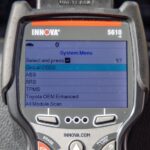Experiencing the frustration of a check engine light in your 2008 Honda Accord can be unsettling, especially when accompanied by an OBD2 code like P2422. This code typically points towards an issue within your vehicle’s evaporative emission control (EVAP) system, specifically indicating a stuck closed vent valve. While diagnosing EVAP system problems can sometimes be complex, a common culprit, particularly in older vehicles, is moisture accumulation within the vapor canister. This article will guide you through a DIY approach to investigate and potentially resolve a P2422 code on your 2008 Honda Accord by focusing on removing moisture from the vapor canister.
Before diving into the specifics, it’s crucial to understand that the P2422 code, defined as “Evaporative Emission Control System Vent Valve Stuck Closed,” suggests that the vent valve within your EVAP system is not opening and closing as it should. This valve plays a vital role in venting fuel vapors and maintaining proper system pressure. A stuck closed valve can disrupt this process, leading to the P2422 error code and triggering your check engine light.
When faced with a P2422 code on a 2008 Honda Accord, a systematic approach to troubleshooting is always recommended. Initial checks should include verifying the functionality of key components within the EVAP system. These components include:
- Fuel Tank Pressure Sensor: This sensor monitors the pressure within the fuel tank, providing crucial data to the engine control unit (ECU) about the EVAP system’s status.
- Vapor Canister Purge Valve: This valve controls the flow of fuel vapors from the vapor canister to the engine intake manifold for combustion.
- Vent Lines: These lines carry fuel vapors throughout the EVAP system. Inspecting them for obstructions, damage, or improper connections is essential.
Ensuring these components are in good working order and that vent lines are clear is a fundamental step in diagnosing P2422. However, sometimes, even with these components functioning correctly, the P2422 code persists. This is where the issue of moisture within the vapor canister becomes relevant.
Moisture can accumulate in the vapor canister over time due to various factors, including condensation and environmental humidity. This moisture can interfere with the vent valve’s operation, potentially causing it to stick closed and trigger the P2422 code. If initial checks of sensors, valves, and lines don’t resolve the issue, investigating the vapor canister for moisture is a logical next step.
A DIY approach to address potential moisture in the vapor canister involves carefully removing the canister and attempting to drain any accumulated water. One effective method, as demonstrated by experiences with similar Honda models, is to use compressed air to expedite the moisture removal process.
Caution: If you decide to use compressed air, it is imperative to remove the fuel tank pressure sensor from the vapor canister before applying any air pressure. Failure to do so can severely damage the sensor, necessitating replacement.
To perform this procedure:
- Locate and remove the vapor canister. The location can vary slightly, but it’s typically found near the fuel tank. Consult your 2008 Honda Accord repair manual for the exact location if needed.
- Disconnect the vapor canister purge valve and any associated lines.
- Carefully remove the fuel tank pressure sensor from the canister. Store it in a safe place.
- Detach the vapor canister from its mounting frame. This allows for easier manipulation during the moisture removal process.
- Orient the canister with the purge port facing downwards. This will help gravity assist in draining any liquid.
- Gently apply compressed air to the various ports on the vapor canister. Start with low pressure and gradually increase as needed. You should observe water dripping out of the purge port.
- Continue applying compressed air intermittently. You may notice a strong fuel vapor smell as the moisture is expelled and fuel vapors are purged.
- Persist until water dripping ceases and only fuel vapor is noticeable. This may take several minutes.
DIY moisture removal process from a 2008 Honda Accord vapor canister to address OBD2 code P2422.
After completing the moisture removal procedure, reassemble all components:
- Reinstall the vapor canister onto its mounting frame.
- Reconnect all vent lines and the vapor canister purge valve.
- Carefully reinstall the fuel tank pressure sensor. Ensure it is securely connected.
Following this DIY moisture removal process, it’s advisable to monitor your 2008 Honda Accord to see if the P2422 code reappears. In many cases, removing accumulated moisture can effectively resolve the issue, clearing the check engine light and restoring proper EVAP system function. If the P2422 code persists after this procedure, further diagnostics by a qualified automotive technician may be necessary to pinpoint other potential causes within the EVAP system.
Disclaimer: This DIY guide is based on a personal experience and is intended for informational purposes only. Automotive repair should be performed with caution and proper safety procedures. If you are not comfortable performing this procedure yourself, it is recommended to seek assistance from a certified mechanic.
